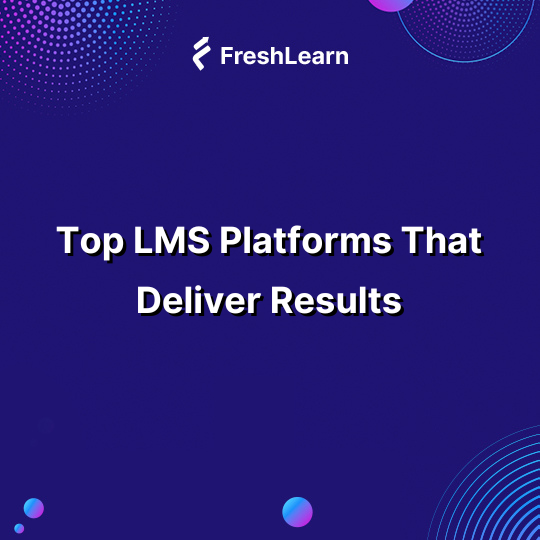
Top LMS Platforms That Deliver Results
Is your online course taped together by a dozen different apps?
If you're using one tool for payments, another for video hosting, and MS Excel to track who actually finished the modules, you're (unfortunately) among the majority of course creators.
But this trainwreck of a system is actually holding you back. If you could manage all the creation and marketing, and analytics from one tool, wouldn’t you have lots of time to sharpen your teaching?
We're cutting through the noise to compare the LMS platforms that trade that chaos for a single, organized dashboard.
Grab your coffee, close those 19 other comparison tabs, and let's find the right home for your courses.
Top LMS Platforms: At a glance
No time to read a lot? We have you covered; just scan through this table and you’ll get a good idea of what each platform does best and who it’s meant for.
Best for course creators and entrepreneurs
If you want to build, market, and sell without a tangle of tools, start here — faster setup, sales features, and simple admin matter most in this category.
- FreshLearn: All-in-one school, zero transaction fees, AI to draft outlines and quizzes
- TalentLMS: Quick launches, handy automations, and an AI course generator
- iSpring Learn: Rapid authoring with iSpring Suite, straightforward paths, and tracking
- Moodle: Open source control and plugins if you are comfortable tinkering
Best all-around LMS for businesses
These are balanced choices if you need clean delivery, reporting, and integrations across employees, customers, and partners.
- LearnUpon: Multi-portal structure and in-product learning for customer education
- Docebo: Headless options and AI orchestration for complex programs
Best for enterprise and large corporations
Pick when compliance, scale, and deep governance are non-negotiable, and learning needs to connect to broader people systems.
- SAP SuccessFactors Learning: Integrates with HR and skills processes with enterprise-grade compliance
- Cornerstone Learning: AI skills graph, certifications, and global scale controls
- Absorb LMS: Multi audience training with analytics and ecommerce options
Best for collaborative and peer-to-peer learning
These are great when subject experts co-create content, and discussion is part of the pedagogy.
- 360Learning: Collaborative authoring and social learning at its core
- Blackboard Learn: Modern experience with AI course builds and robust assessment
Top LMS Platforms: In-Depth Reviews
Without further ado, here are all the deets about all these LMS platforms.
1. FreshLearn
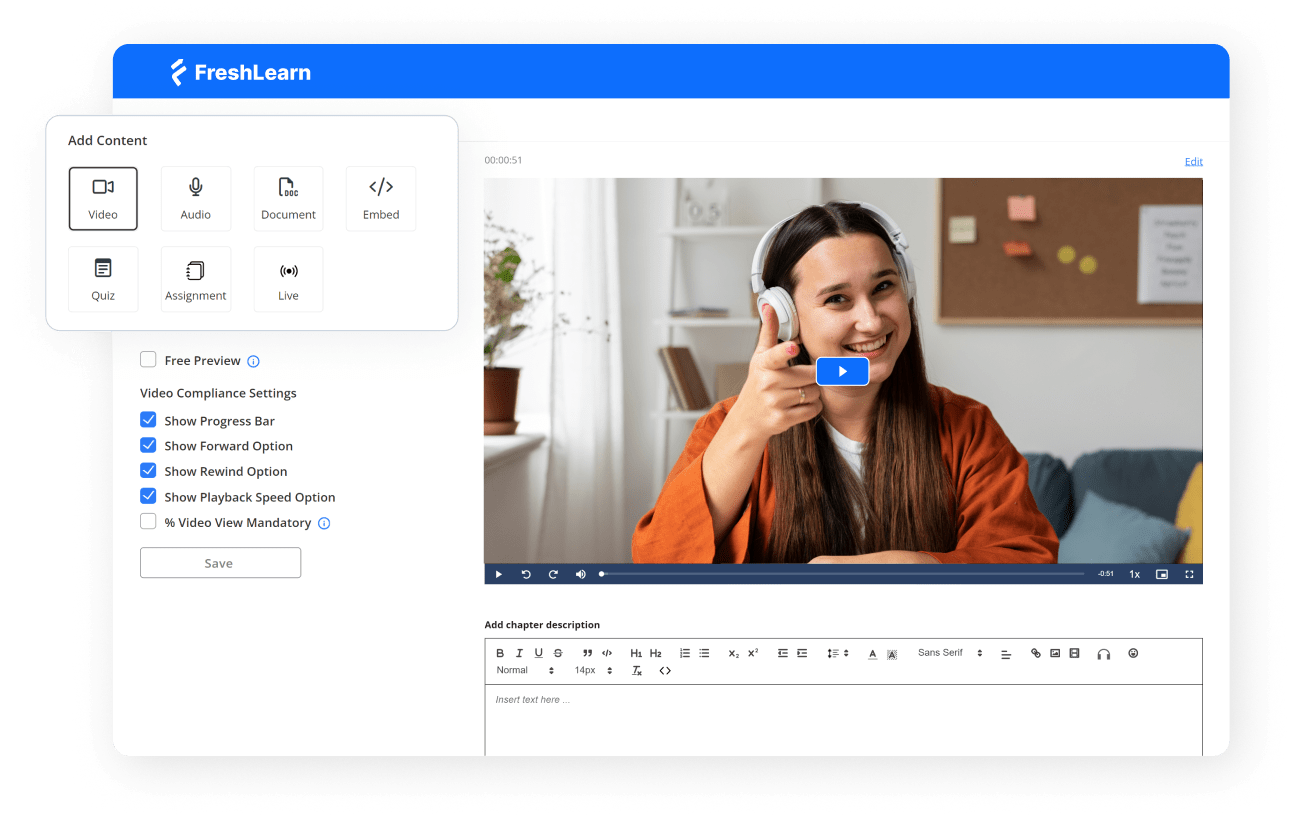
Via FreshLearn
FreshLearn is the LMS built for creators who want to develop, market, and sell from the same platform in the easiest possible way, without sacrificing features.
FreshLearn provides courses, cohorts, live workshops, memberships, a community, a website and blog, email campaigns, and checkout all under one roof. There are no transaction fees and unlimited enrollments, which means your revenue stays yours while you scale. The experience feels purpose-built for solo builders who need momentum.
FreshLearn’s USP is speed with control. Don’t believe us? You can start a branded academy, publish an outline, collect payments through popular gateways, and start teaching in one sitting. It also adds automation for enrollments, certificates, and drip schedules, and mobile apps help learners keep pace on the go, which lifts completion and trust.
Moreover, FreshLearn’s AI Agents help you validate ideas, generate course outlines, draft lesson content, and build quizzes. You can even use the no-code website builder to assemble pages that match your brand.
From the learner's side, the flow is clean. Clear modules, progress tracking, and thoughtful compliance touches like certificates and assignments keep things organized. Built-in analytics show you what people finish, where they stop, and which offers bring in conversions.
Best For
Individual creators and small teams who want an all-in-one academy builder with AI and built-in marketing
Key Features
- Zero transaction fees with unlimited enrollments and branded checkout
- AI Agents for idea validation, course outlines, lesson drafts, and quiz generation
- Courses, cohort programs, live workshops, memberships, community, playlists, and digital downloads
- Website and blog builder, email campaigns and newsletters, referrals for affiliates, coupons, and bundles
- Mobile apps for learners on iOS and Android with brand customization
- Powerful analytics with a single dashboard that tracks progress and engagement
Pros
- Praised for ease of use and fast setup for solo creators
- Live support and migration help are called out repeatedly as a difference maker
- Strong value for money with an actual all-in-one stack and no transaction fees
- Templates and built-in pages make launching and iterating quick
Cons
- Some reviewers want deeper analytics and reporting detail
- Integrations can feel limited for complex stacks
Pricing
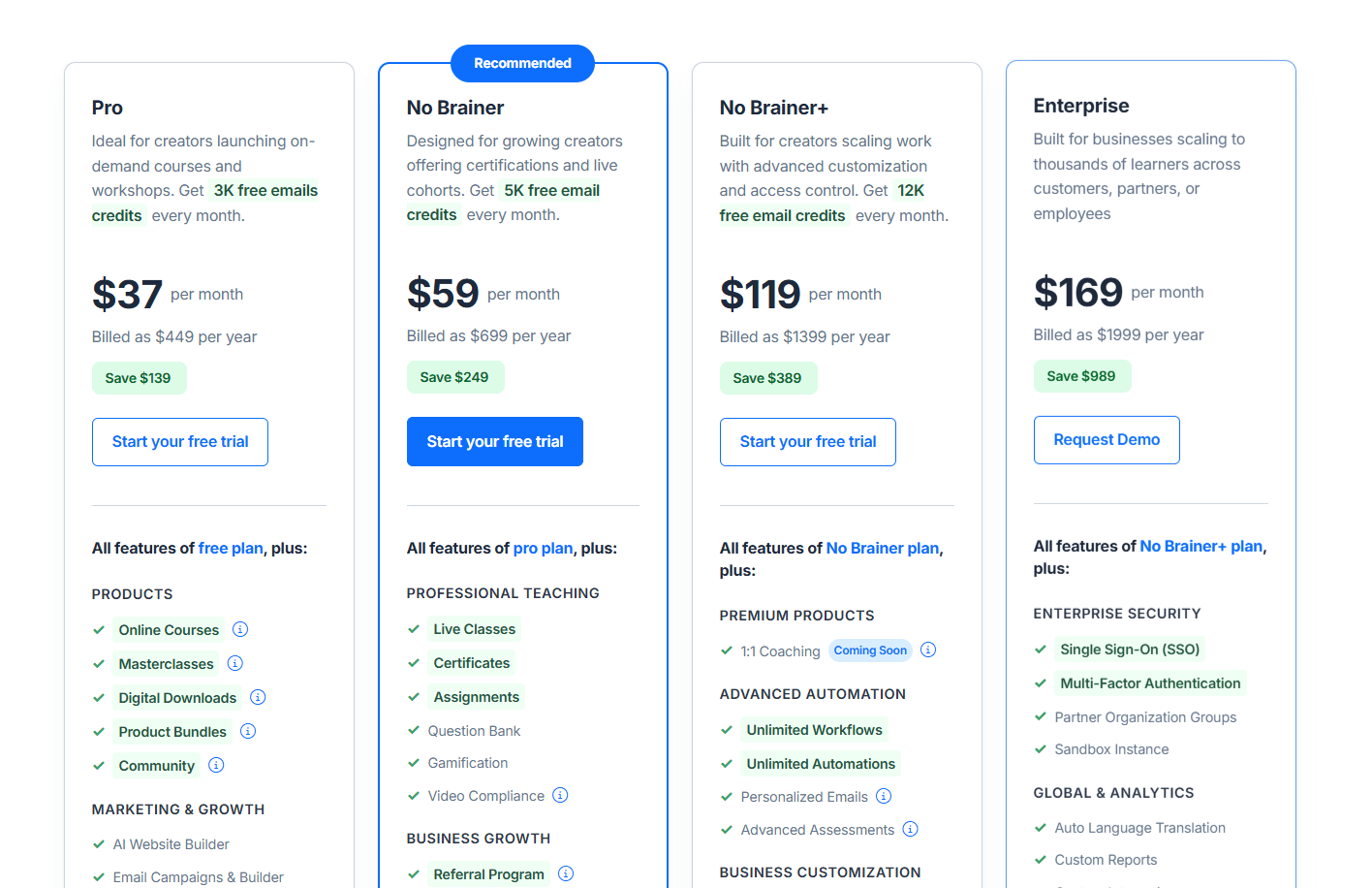
Via FreshLearn
FreshLearn supports creator-friendly pricing. You get to choose from tiers designed for different needs.
- Start Free with one product, manual enrollments, and email support
- Pro: $49/month or $37/month billed yearly.
- No Brainer: $79/month or $59/month billed yearly
- No Brainer Plus: $149/month or $119/month billed yearly
- Enterprise: $249/month or $169?month dollars per month billed yearly
Free migration is available on select yearly plans.
Why is it the best pick for individual creators?
If you want to earn from your expertise with minimal friction, FreshLearn gives you the shortest path from idea to income.
You can validate demand with AI, create the first version in a weekend, open enrollment with a modern checkout, and nurture learners with email and community without ever leaving the platform.
Pricing, too, stays friendly as you grow because the platform does not take a cut. This combination is hard to beat for a solo builder who wants to move fast and keep control.
2. Absorb LMS
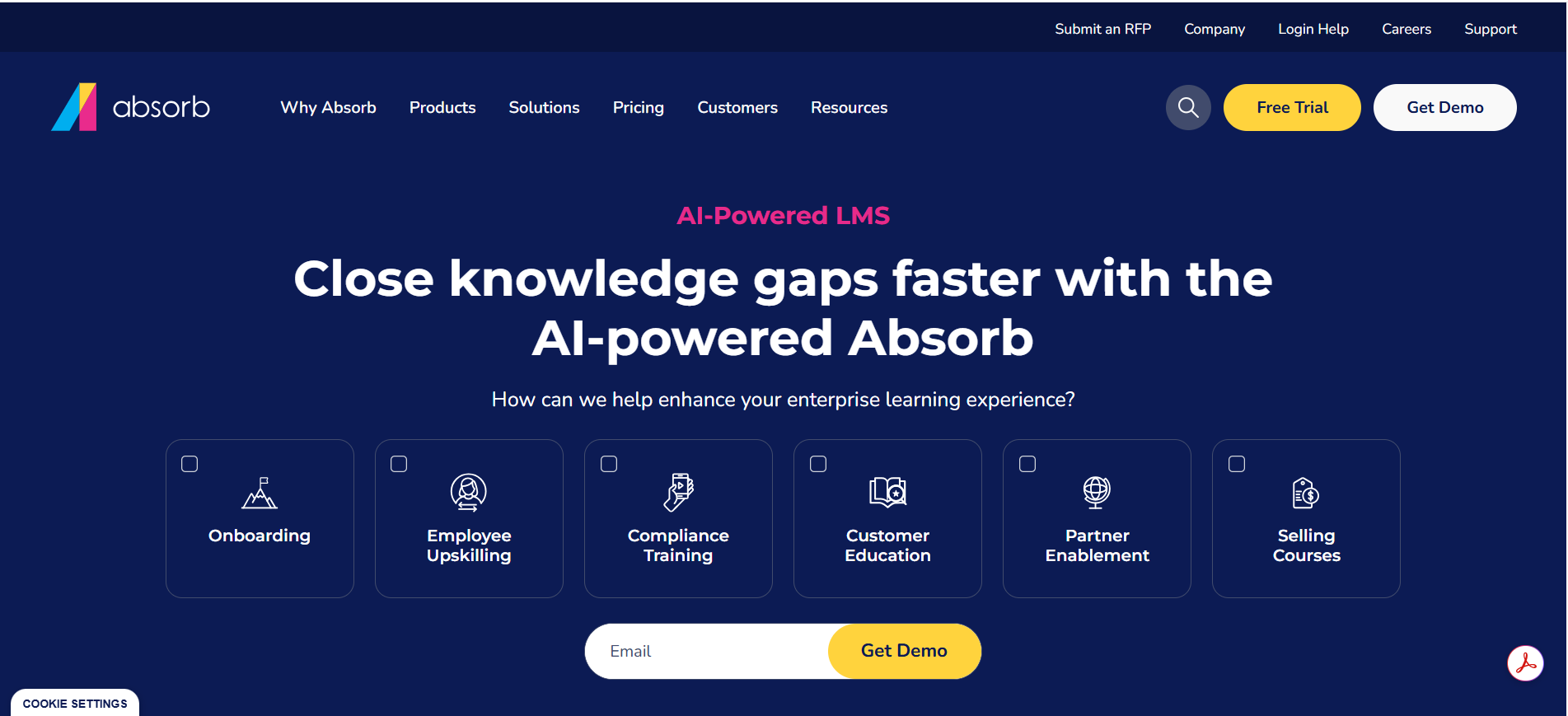
Via Absorb LMS
Absorb is built for organizations that need scale without sacrificing polish. It’s an AI-powered LMS that handles employee, customer, and partner education from a single place, with a clean learner UI and an admin experience that doesn’t feel like a maze. If you’re handling compliance, onboarding, and product training simultaneously, Absorb is designed to keep everything tidy and measurable.
Where it really differs is “learning in the flow of work.” Absorb Infuse is a headless option that allows you to embed the learning experience directly within the apps people already use, such as your CRM, product, or portal. That’s a rare capability even among enterprise LMS platforms.
Creators get modern authoring and video-centric tools. Absorb Pinpoint auto-transcribes your videos, timestamps them, and makes them searchable — your learners can jump straight to the moment they need. That turns long recordings into snackable micro-lessons without heavy editing.
From the learner side, Absorb offers a branded web experience and a mobile app with offline access. If you sell lessons, there’s a built-in eCommerce module that allows you to list, discount, and track purchases without adding a storefront.
Best For
Mid-market and enterprise teams that want a polished LMS with “in-the-flow” delivery and optional eCommerce
Key Features
- Headless delivery with Absorb Infuse (embed training in your own apps)
- AI-assisted video microlearning via Absorb Pinpoint
- Reporting and analytics dashboards for compliance and impact
- e-commerce for selling courses (coupons, tax, pricing rules)
- Mobile app with offline learning
Pros
- Easy for admins, learners praise the clean UI
- Responsive customer support
- Scales for multi-audience training (internal + external)
- Video search (Pinpoint) speeds up “find the answer” moments
Cons
- Lacks deeper customization of the learner portal
- Reporting depth and exports can feel limited for certain teams
- eCommerce and marketing options are not as flexible as some expect
Pricing
Customized for business needs: Absorb matches pricing to learner counts, audiences (internal and external), and add-ons. You can avail a free trial and live demo.
3. 360Learning
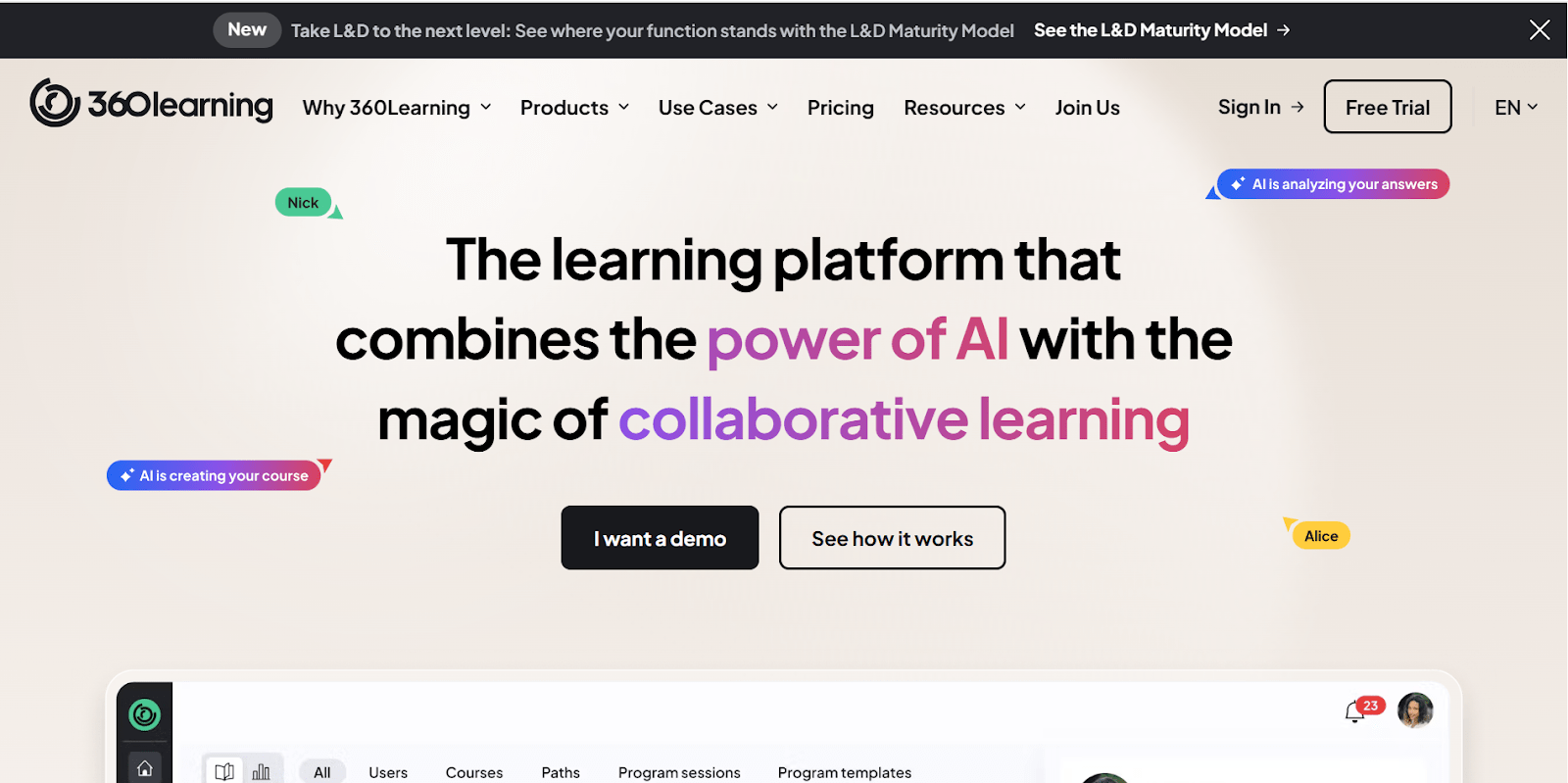
Via 360Learning
If you want creation and collaboration to be inside your LMS, 360Learning leans into that idea more than most. It’s an AI-powered platform with fast, friendly authoring that invites subject-matter experts to co-build courses, comment, and iterate.
The platform is unique for its collaborative DNA: templates, built-in forums, and controlled AI prompts help you create content quickly while maintaining quality and consistency. Translation workflows and cohort management make it practical for global rollouts, too.
As a creator, you’ll appreciate the fast course builder. You can import content, convert docs, generate quiz questions, and version courses, all within the same screen. Then automate the unglamorous work, including enrollments, reminders, expirations, and certificates.
Learners receive an approachable UI, blended learning paths (combining self-paced and live components), and mobile access. Managers get dashboards that show progress and completions. Integrations with HRIS, Salesforce, Zoom, and MS Teams keep training in the flow of work.
Best For
Teams that need fast, collaborative course creation and automation across onboarding, compliance, and enablement.
Key Features
- Integrated, AI-assisted authoring (document and prompt-based)
- Automated enrollments, re-enrollments, and certificate tracking
- Blended learning with smart ILT scheduling and e-signature check-in
- Multilingual creation and translation workflow and consolidated stats
- Manager and group dashboards with downloadable custom reports
Pros
- Very easy to create content, and its collaborative authoring shines
- Friendly learner UI with strong customer support
- Data views and manager dashboards are useful
- Good mobile and blended learning experience
Cons
- Initial learning curve for admins; some navigation confusion
- Live sessions, event features, and reporting can feel limited
- AI tools are still maturing in places
- Occasional reliability and UX quirks noted by reviewers
Pricing
- Team: $8 per registered user/month, up to 100 users
- Business and Enterprise: custom pricing (contact sales)
4. LearnUpon
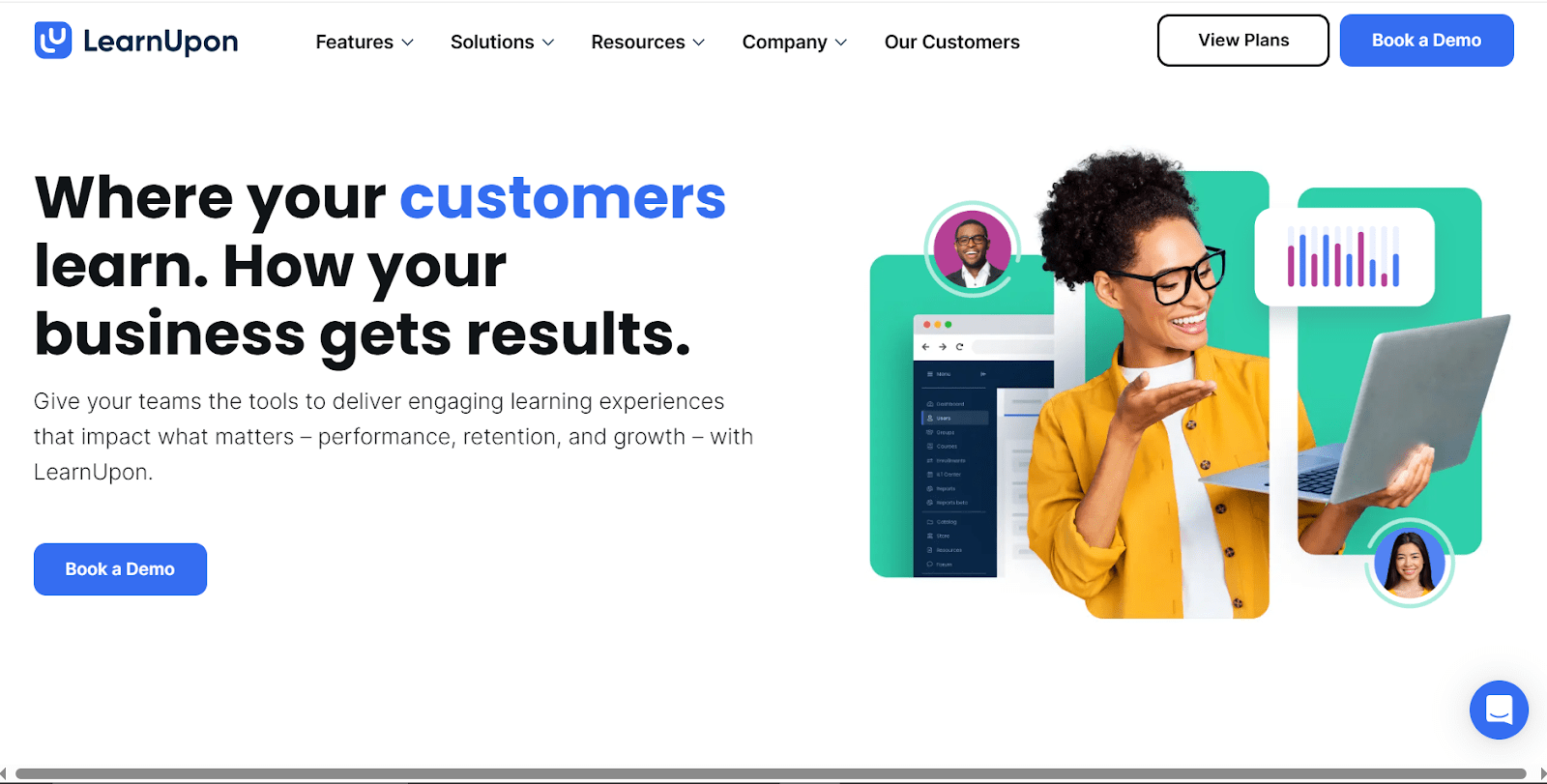
Via LearnUpon
LearnUpon is an LMS that focuses on clear training delivery across multiple audiences. You can create dedicated “portals” for each group, such as employees, customers, and partners, and manage them as separate experiences under one roof. That keeps your catalogs and branding clean while giving you a single place to report on results.
Arguably, the USP here is LearnUpon Anywhere: instead of sending users to the LMS, you can embed courses directly inside your product or website. That’s powerful for customer education because learners complete training in the exact moment it’s needed. Admins still create, enroll, and track from the core LMS.
For creators, LearnUpon’s AI features help with summaries, question banks, scripts, translations, and media. Combined with its integrations and SSO options, it’s a practical stack for teams that prefer structure, automation, and clean delivery over tinkering.
From the learner side, separate portals mean a focused, branded space that feels like theirs, and embedded courses (via Anywhere) remove the detour entirely.
Best For
Customer, partner, and employee training teams that want multi-portal control and in-product learning.
Key Features
- Multiple portals with distinct branding, catalogs, and permissions under one LMS
- LearnUpon Anywhere lets you embed courses in your app and site and track them centrally
- AI-assisted summaries, quizzes, translations, and media
- Many integrations for HRIS, CRM, and webinar workflows
Pros
- Very easy to use; smooth setup and navigation
- Highly rated customer support and success teams
- Clear learner experience; portals help segment audiences
- Fast course creation and helpful training materials
Cons
- Limited customization in branding, emails, and journeys
- Reporting depth and analytics can feel constrained
- Some integration pain points with Microsoft and HRIS
- Navigation quirks with learning paths and search for some users
Pricing
Pricing isn’t publicly listed; contact LearnUpon for a quote
5. Docebo
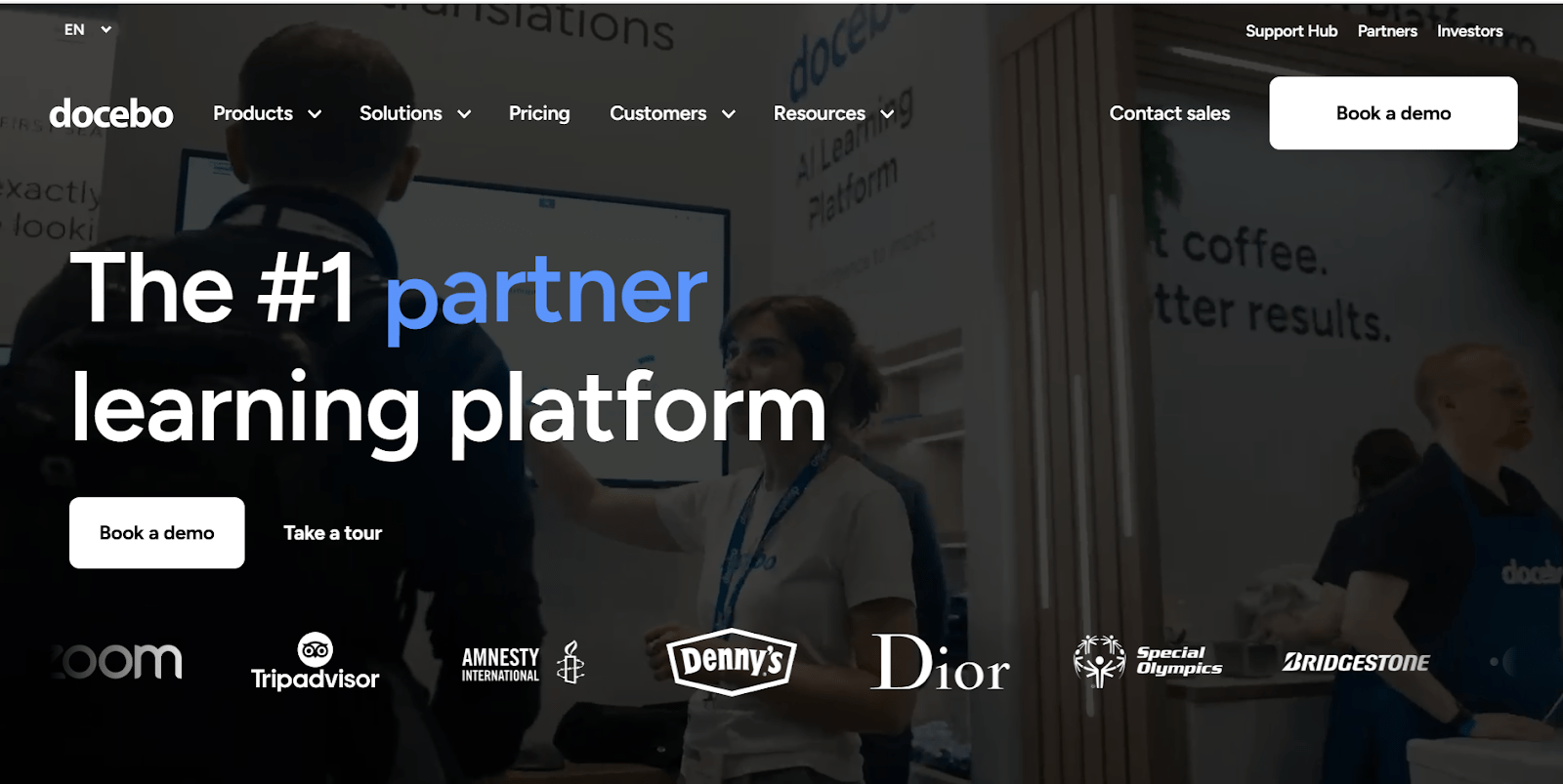
Via Docebo
Docebo is an AI-first learning platform that can serve employees, customers, and partners at scale. Its Harmony engine automates a significant amount of the heavy administrative work and personalizes what learners see, while the platform provides granular control over how learning is presented across your business.
Instead of forcing everyone to come to a single portal, Docebo lets you embed learning directly inside your own product, website, or mobile app using a toolkit of APIs, webhooks, and prebuilt widgets. It helps reduce context switching and makes learning feel native to the flow of work.
If you create courses, Docebo focuses a lot on speed. You can use AI to create courses, assessments, and even coaching simulations. It also connects to a marketplace of ready content, so you can mix your own material with curated catalogs.
Learners are met with flexible experiences on the web and mobile. The Go Learn app supports offline access, allowing users to download content, learn on the go, and sync their progress later. This is ideal for frontline teams and field roles that lack consistent connectivity.
Best For
Enterprises that want an AI-powered, highly configurable LMS that they can embed into their own digital experiences.
Key Features
- AI orchestration through Harmony to automate tasks and personalize journeys
- Headless learning to deliver training inside your apps and sites with APIs, webhooks, and widgets
- AI course creation and instant translations with Creator, plus access to a broad content marketplace
- E-commerce to sell courses through catalogs and subscriptions
- Mobile learning with offline mode through the Go Learn app
Pros
- Frequently praised for ease of use and strong support
- Custom branding and flexible configuration get high marks
- The active user licensing model is attractive to many buyers
- Scales well for complex programs across audiences
Cons
- Reviewers report gaps or limits in certain features
- Some note customization limits in specific areas, like reporting and widgets.
- Performance or unfinished features have been mentioned in rollouts.
- It can be pricey for smaller teams
Pricing
Quote-based with pricing tied to yearly active users and product tier. There are two primary tiers — Elevate and Enterprise, with add-ons available.
6. TalentLMS
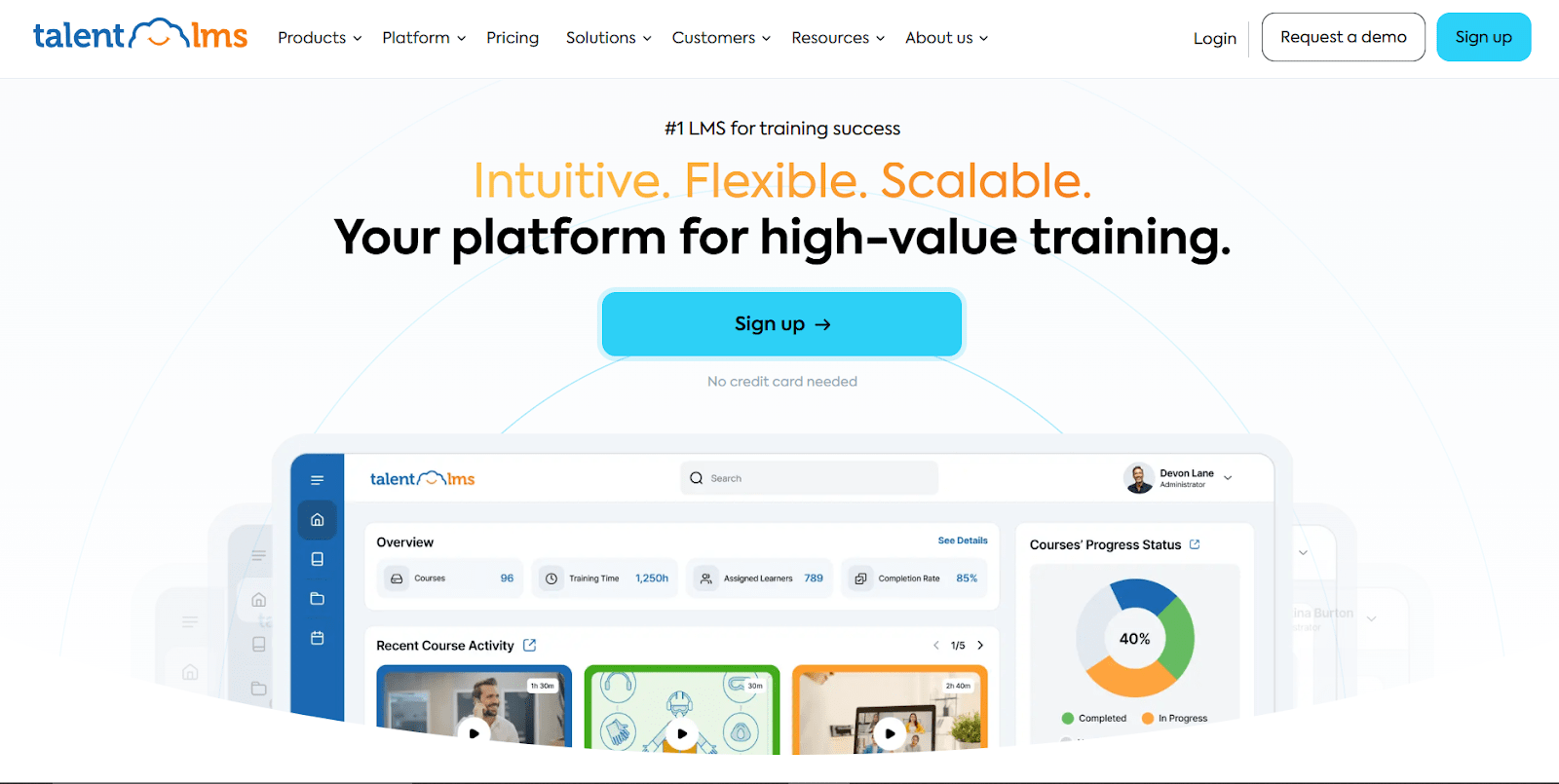
Via TalentLMS
TalentLMS is an LMS that advertises to be built for high-value training. You sign up, switch on the features you need, and start assigning courses. That straightforwardness is the main draw, especially for small and midsize teams that want learning to happen fast.
In TalentLMS, a lot of capability is bundled into transparent plans. You get branches to create separate portals for different audiences, a solid analytics layer, and enterprise basics like single sign-on (SSO), a public API, and LTI 1.3. The new wave of AI features is notable too, including an AI course generator, an AI test creator, an AI translator for entire courses, and an AI Coach that helps learners inside lessons.
Its TalentCraft system also speeds up authoring, automations reduce repetitive assignments, and you can bring in ready content from TalentLibrary when you need to fill skills quickly. Support resources are easy to reach, and the whole system is designed to scale from a small user base to hundreds without becoming brittle.
From the learner side, the experience is simple to navigate and works across devices. If you rely on standard content packages such as SCORM and xAPI, TalentLMS supports them, so your existing courseware slides right in.
Best For
Teams that want a fast, affordable rollout with modern AI authoring and clean admin controls.
Key Features
- AI course generator, AI test creator, AI translator, and AI Coach
- Branches for multiple audiences, custom homepages, and a custom domain
- Single sign-on with SAML 2.0, LDAP, OpenID Connect, public API
- Analytics with customizable dashboards and reports
- LTI 1.3 support and compatibility with SCORM and xAPI
Pros
- Consistently highlighted for easy setup and intuitive navigation.
- Responsive support and helpful onboarding resources
- Strong value for the feature set and a clear upgrade path
- Useful AI features help creators produce content faster
Cons
- Some reviewers want deeper reporting and cleaner navigation
- Design flexibility can feel limited for advanced branding
- A few note hiccups, like broken image links when duplicating courses
- Costs can rise as usage grows
Pricing
- Free plan available
- Core: $119 per month on annual billing
- Grow: $229 per month on annual billing
- Pro: $449 per month on annual billing, with an extra charge per additional user at higher usage
- Enterprise: Custom
7. SAP SuccessFactors Learning
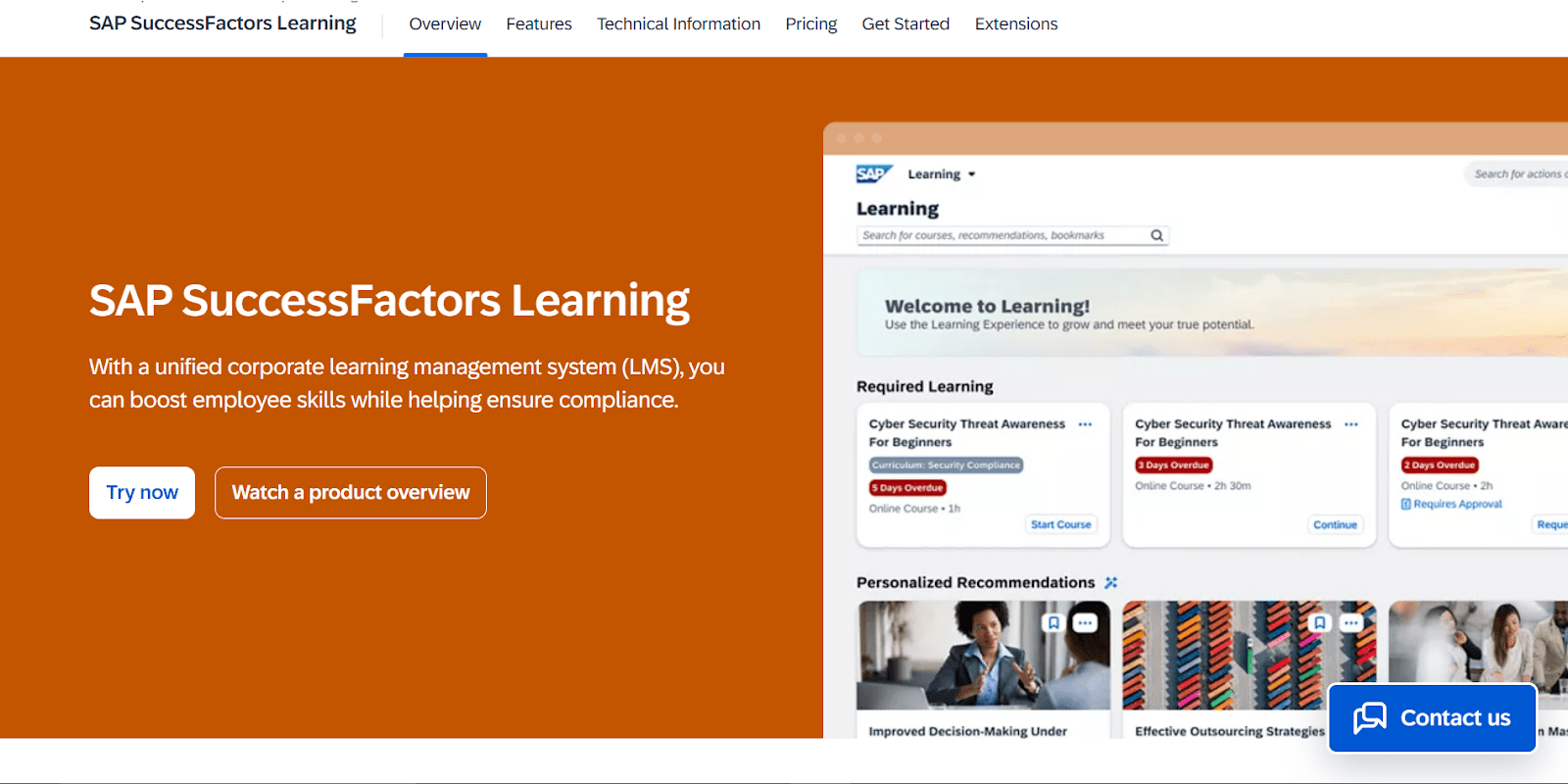
SuccessFactors Learning is the enterprise choice inside SAP’s HCM suite. It shines when learning must connect to talent processes like onboarding, performance, and skills, with a focus on compliance and scale.
Its edge against competitors comes from deep integration across the SAP ecosystem and a skills-driven model supported by AI recommendations. Learning shows up in the flow of work through integrations such as Microsoft Teams, and it identifies opportunities like mentoring or fellowships through the Opportunity Marketplace. That makes it easier to convert training into visible mobility paths.
Creators and admins get industrial-strength compliance tooling. You can automate mandatory assignments, manage documents with e-signatures, and generate detailed compliance reports. There is also a learning commerce capability that tracks costs and tuition for paid training.
The official app supports learning on the go and offline downloads, which is essential for distributed workforces and regulated industries that rely on validated mobile experiences.
Best For
Large organizations need learning tightly integrated into HR, compliance, and skills programs on a global scale.
Key Features
- Personalized learner home with AI-driven recommendations and skills intelligence
- Compliance automation with required assignments, e-signatures, and comprehensive reporting
- Learning in the flow of work, including Microsoft Teams integrations
- Mobile and offline learning through the SuccessFactors app
- Visibility across the SAP HCM suite and integration with the Opportunity Marketplace
Pros
- Reviewers like the integration with other SAP modules and the ability to track learning centrally
- Praised for structuring required training and keeping compliance visible
- Mobile access and offline options come in handy
- Can easily handle learner management on a very large scale
Cons
- Some users report that performance sometimes lags, and navigation can feel heavy in large deployments
- Implementation and integration can be complex, which adds time and cost
- Some reviewers call out a learning curve for both admins and end users
- Cost is a common concern for smaller organizations
Pricing
Quote-based. SAP lists pricing as per user per month and per user per year models.
8. iSpring Learn
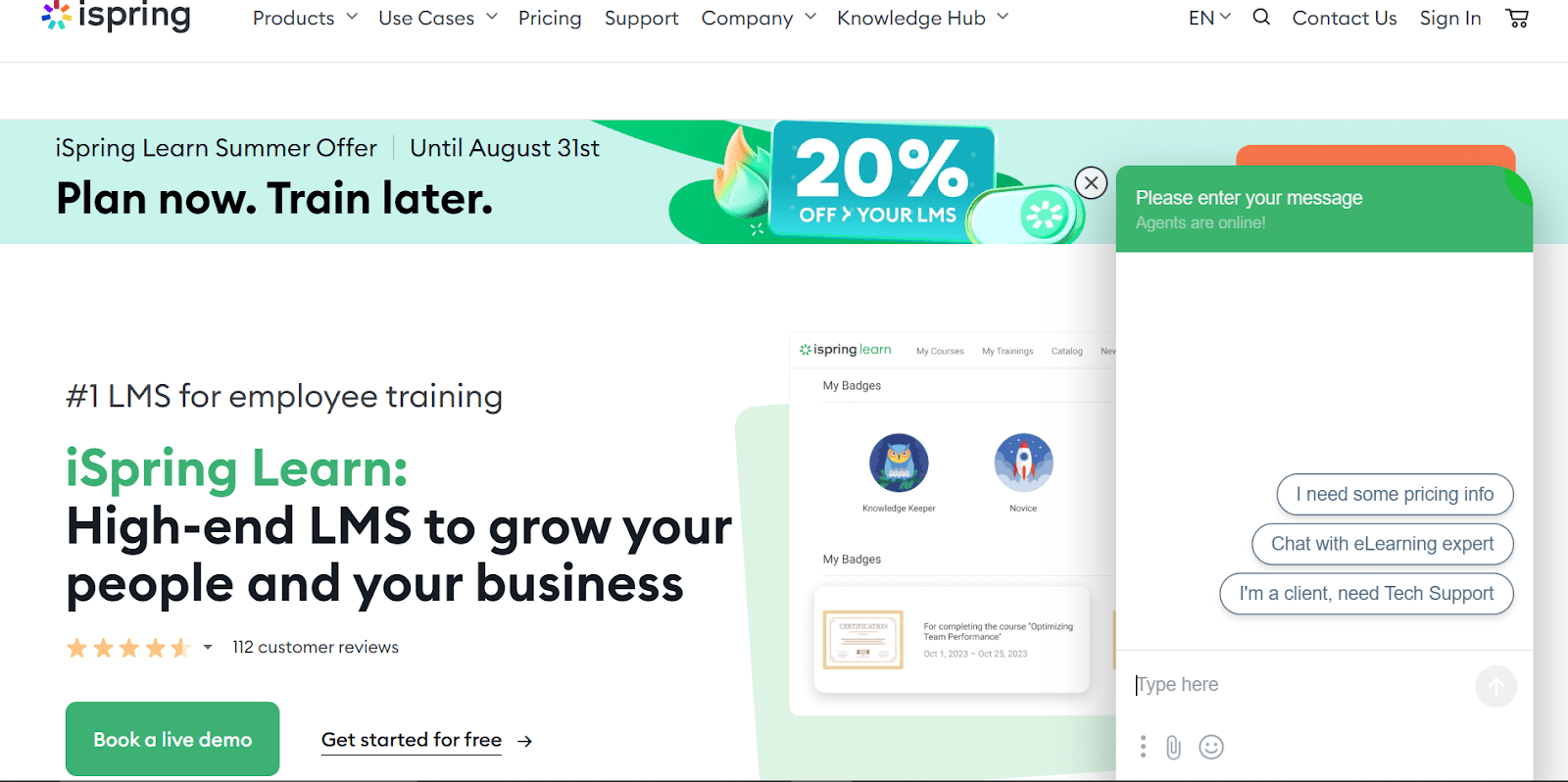
Via iSpring Learn
iSpring Learn is a corporate training LMS designed for teams that want to transition from zero to live training without a complicated process. The platform encompasses the entire spectrum of corporate learning, covering creation, management, distribution, and tracking, with intuitive admin controls and straightforward navigation for learners.
When you license iSpring Learn, you can also include iSpring Suite, a complete authoring toolkit that lets creators build media-rich lessons, quizzes, and interactive content straight from familiar workflows. That pairing removes the usual friction between making content and publishing it to the LMS.
You can stitch courses, assessments, and files into step-by-step learning paths that roll out over days or months. The system also handles assignments and reporting in the background.
The mobile app is also polished. Learners can download content for offline study, pick up where they left off, and sync progress when they reconnect.
Best For
Companies that want fast rollout, built-in authoring, and a strong mobile experience with offline access.
Key Features
- Learning workflows that sequence courses, assessments, and resources over time
- iSpring Suite authoring is included with the LMS to build interactive content quickly
- Detailed analytics and dashboards for courses, people, and assessments
- Native mobile apps with offline learning and automatic progress sync
- REST and SOAP API to integrate learning data with other systems
Pros
- Frequently praised for ease of use and a short learning curve
- Responsive support noted by buyers
- Tight pairing with iSpring Suite speeds content creation
- Tracking and learning paths are quite effective
Cons
- A portion of reviewers want deeper reporting and broader customization
- A few complaints of missing features compared with larger enterprise suites
- Costs can climb as active user counts grow
- Some remarks about needing more advanced widgets and dashboards
Pricing
You pay for active users in a given month. You can invite unlimited users and pay only for those who log in.
9. Moodle
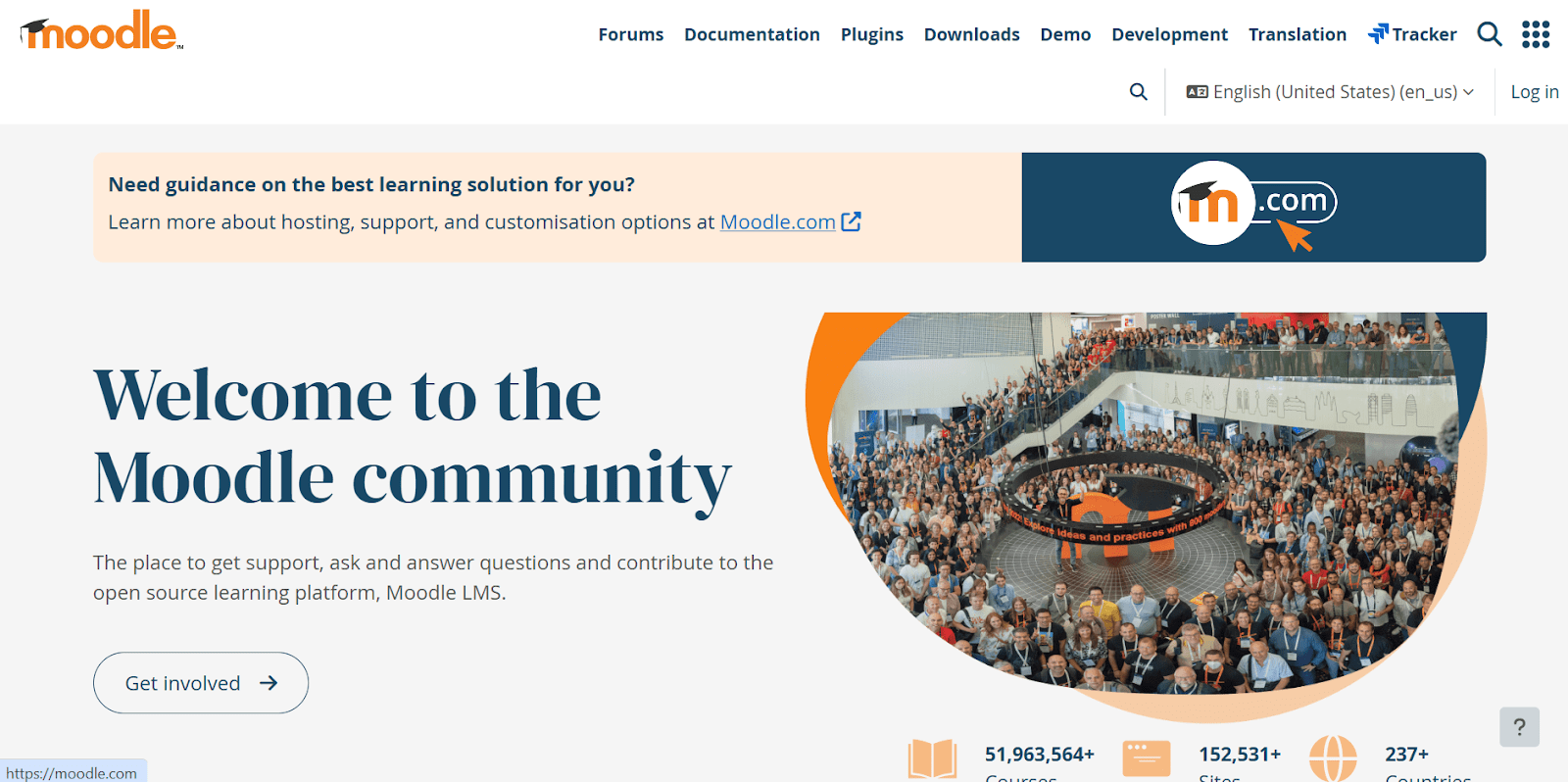
Via Moodle
Moodle is the open-source LMS used across education and workplaces around the world. You get a full set of teaching and learning tools in one place, from enrollments and course creation to grading and competencies. Institutions prefer Moodle because it is flexible, secure, and designed to be customized to the way you teach.
Since the software is open-source, you can download it, host it yourself, and modify it to fit your specific needs. That freedom unlocks a vast ecosystem of plugins, themes, and integrations maintained by a global community. If you prefer hosting handled for you, MoodleCloud delivers the same core LMS as a managed service.
As a creator, you can assemble rich courses with forums, assignments, quizzes, and collaborative activities, then align them to competencies and learning plans.
The official Moodle App supports offline access for many activities, then syncs when connectivity returns, which is a must for campuses and training programs with patchy bandwidth.
Best For
Schools and training teams that want maximum flexibility, ownership, and an open ecosystem backed by a massive community.
Key Features
- Course authoring with forums, assignments, quizzes, and collaborative tools
- Competencies and learning plans tied to assessments and progress
- Gradebook and reporting to measure outcomes
- Mobile app with offline access and syncing
- Open-source codebase with plugins, themes, and self-hosting options
Pros
- Reviewers love the flexibility and depth of features for course design
- Strong community resources and documentation
- Broad plugin ecosystem and customization potential
- Mobile learning is widely appreciated
Cons
- Some find the interface dated or clunky and note a learning curve
- Upgrades and maintenance can require dedicated admin time
- Visual branding and layout options can feel constrained without extra work
- Performance depends on your hosting and configuration
Pricing
Moodle LMS core is free to download and use under the GPL license.
Paid plans are priced as follows
- Small: $460 per year for 100 users
- Medium: $1,110 per year for 200 users,
- Standard: $1,950 per year for 750 users.
A custom domain is included on the Standard plan and offered as an add-on for Medium.
Want a detailed breakdown? Check out our full guide on Moodle Pricing.
10. Cornerstone Learning
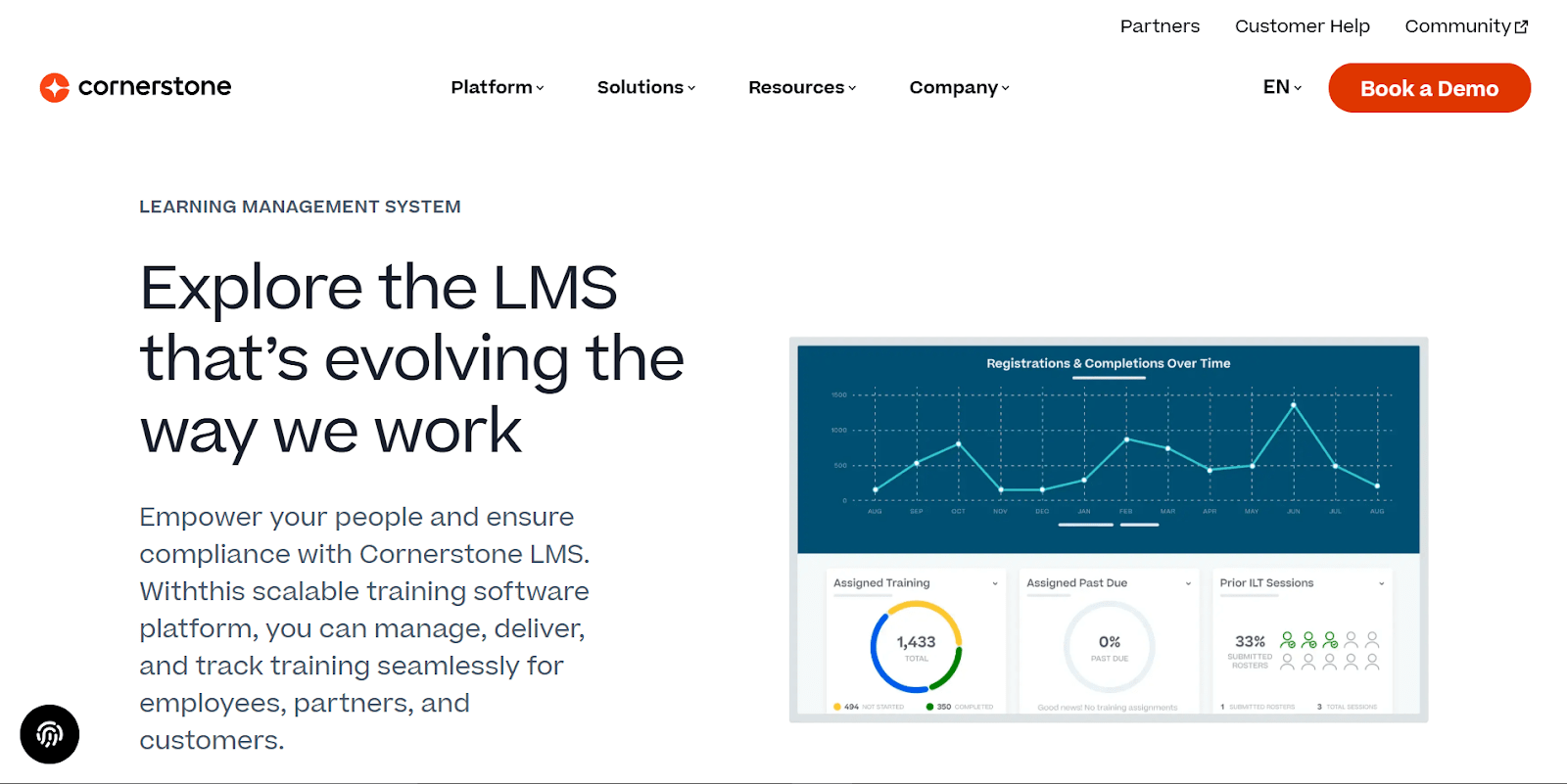
Via Cornerstone LMS
Cornerstone is an enterprise-grade learning platform used to run compliance, upskilling, and large-scale development programs across a complex workforce.
This LMS lets you manage learning for employees, customers, and partners, while AI helps map skills, recommend content, and tie development to performance. That mix works well when you care about both mandatory training and strategic growth.
One of its best features is the Cornerstone Skills Graph, a system that uses ML to detect and map capabilities across people, roles, and content, then powers personalized development plans.
You also get enterprise controls for certifications, external training, and manager visibility. And because learning often happens away from a desk, the Cornerstone mobile app supports on-the-go training, with support for viewing online courses offline when enabled by your organization.
Best For
Enterprises that want AI-driven skills development, rigorous compliance, and deep controls at a global scale.
Key Features
- AI-powered Skills Graph to identify gaps and recommend development
- Content Studio for discovery, curation, creation, and insights
- Compliance and certification management for regulated environments
- Mobile learning with the Cornerstone app and optional offline course access
- Customer and partner training options with e-commerce
Pros
- Scales well for global compliance and complex org structures
- Strong reporting and tracking noted across reviews
- Skills and content capabilities help align learning to growth goals
- Comes with a helpful enterprise community
Cons
- Users mention a steep learning curve and an interface that can feel heavy
- Some report missing or unfinished features and slower support at times
- Implementation can be complex, adding time and cost
- Mobile experience varies by configuration and policy
Pricing
Quote-based with customized proposals. A demo is available to scope licensing and user volumes.
11. Blackboard Learn

Via Blackboard LMS
Blackboard Learn, now part of Anthology, is a mainstay in higher education and professional training. Its design leans into clarity and responsiveness so learners can move through content, discussions, and assessments without friction.
Blackboard’s defining edge today is built-in genAI for course creation. The AI Design Assistant can draft learning modules, test questions, rubrics, and discussion prompts based just on your course context.
You stay in control of the results, editing and tuning complexity on the fly, but the heavy lifting of first drafts is handled for you. That saves hours when you need to come up with a new course shell or revamp an existing one.
You also benefit from thoughtful workflows in Ultra. Content opens in side panels, progress tracking is visible, and grading tools are integrated, which reduces hopping between screens. It is the kind of flow that encourages quick feedback and keeps students engaged.
Best For
Universities, colleges, and professional schools are looking for a modern course experience with AI-assisted authoring and assessment features.
Key Features
- Ultra Course View with streamlined navigation and progress tracking
- AI Design Assistant for modules, assessments, discussions, rubrics, and more
- Integrated grading, analytics, and accessibility workflows
- Mobile app for instructors and students with role-aware capabilities
- Includes integrated accessibility tools and supports competency-based programs
Pros
- Users love the breadth of features for teaching and assessment
- Recent improvements to Ultra and design tools draw positive remarks
- Familiar to many students and faculty, easing adoption
- Strong community resources and active product updates
Cons
- Some reviewers find the interface dated in places and navigation inconsistent
- Customization depth can feel limited without admin support
- Occasional stability or error reports during peak usage
- Learning curve remains a theme for new users
Pricing
Quote-based. However, Anthology offers a free trial of Blackboard Learn.
Course Creation, Uncomplicated with FreshLearn
When we were researching to make this list, it almost felt like speed-dating in the dark in the beginning — everyone claims they’re innovative, but few can actually help you launch a profitable course this weekend.
That’s where we are confident that FreshLearn pulls ahead.
If you’re a creator, you get the whole storefront in one tab: AI to sketch modules and quizzes, a site builder that drags and drops easily, email campaigns baked in, and checkout that takes zero percent of your revenue.
Let’s be transparent, though. If you’re approaching this list as a learner, you’ll want to poke around other platforms too — each houses a different buffet of courses and credential options.
But for the folks on the selling side of the classroom, FreshLearn is the platform that keeps your focus on content and community instead of maintenance and math.
Book a free FreshLearn demo today.
Frequently asked questions
- How do I pick the right LMS without getting lost in demos?
We recommend starting with outcomes. Write the one-line job your LMS must do, like reduce onboarding time by two weeks or certify one thousand partners each quarter.
Next, list your non-negotiables, such as mobile learning, ecommerce, analytics, or data residency. Finally, run a tiny pilot. Build one real course, enroll a small group, and measure time to publish, learner completion, and report clarity. If a platform fails there, it will fail at scale.
2. What do standards like SCORM, xAPI, and LTI mean for me?
SCORM packages track completion and scores.
xAPI captures granular events such as video watched or simulation steps, often to a learning record store.
LTI is the bridge that lets outside tools plug into your LMS with single sign-on and grade return.
3. How long does implementation really take, and what should I plan for?
For a small team, a rollout can happen in two to four weeks if you keep the scope tight.
Week one: connect identity and payments, set branding, and define roles. Week two: import or build a flagship course and test reports. Week three: launch a pilot cohort with real learners and turn on nudges and analytics. Week four, fix the rough edges and document your playbook so the next course is twice as fast.
4. How do I increase engagement and completion once the platform is live?
For that, you can shorten your lessons and add quick wins early. Use weekly nudges with a single clear action.
Mix formats such as video, checklists, and simple practice. Add light community prompts that ask learners to post one insight or one question. Also, offer a certificate or tangible proof at the end and celebrate completions.
Mobile-friendly design also matters more than you think. So does accessibility that follows WCAG guidance. When in doubt, ask a handful of learners what confused them and fix that first.



